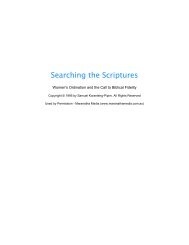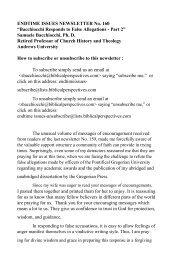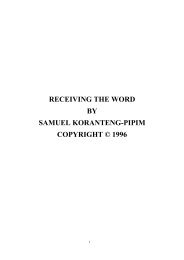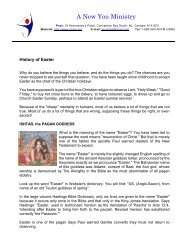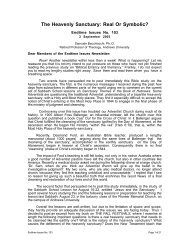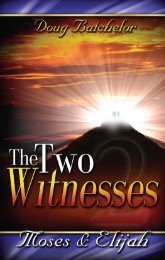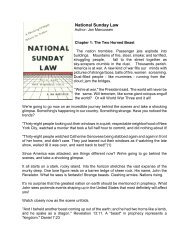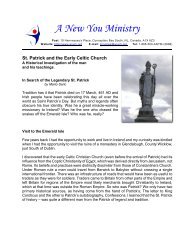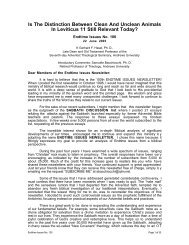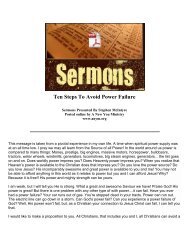Bible Readings for the Home Circleâ1914 - A New You Ministry
Bible Readings for the Home Circleâ1914 - A New You Ministry
Bible Readings for the Home Circleâ1914 - A New You Ministry
You also want an ePaper? Increase the reach of your titles
YUMPU automatically turns print PDFs into web optimized ePapers that Google loves.
BIBLE READINGS<br />
and bring his blood within <strong>the</strong> veil, . . . and sprinkle it upon <strong>the</strong> mercy-seat,<br />
and be<strong>for</strong>e <strong>the</strong> mercy-seat.” Verse 15.<br />
16. Why was it necessary to make this atonement<br />
“And he shall make an atonement <strong>for</strong> <strong>the</strong> holy place, because of <strong>the</strong><br />
uncleanness of <strong>the</strong> children of Israel, and because of <strong>the</strong>ir transgressions<br />
in all <strong>the</strong>ir sins: and so shall he do <strong>for</strong> <strong>the</strong> tabernacle of <strong>the</strong> congregation,<br />
that remaineth among <strong>the</strong>m in <strong>the</strong> midst of <strong>the</strong>ir uncleanness.” Verse 16.<br />
NOTE.— Sins were conveyed into <strong>the</strong> sanctuary during <strong>the</strong> year by<br />
<strong>the</strong> blood of <strong>the</strong> personal sin-offerings offered daily at <strong>the</strong> door of <strong>the</strong><br />
tabernacle. Here <strong>the</strong>y remained until <strong>the</strong> day of atonement, when <strong>the</strong><br />
high priest went into <strong>the</strong> most holy place with <strong>the</strong> blood of <strong>the</strong> goat on<br />
which <strong>the</strong> Lord’s lot fell; and, bearing <strong>the</strong> accumulated sins of <strong>the</strong> year<br />
in be<strong>for</strong>e <strong>the</strong> mercy-seat, he <strong>the</strong>re, in type, atoned <strong>for</strong> <strong>the</strong>m, and so<br />
cleansed <strong>the</strong> sanctuary. {241<br />
241}<br />
17. After having made atonement <strong>for</strong> <strong>the</strong> people in <strong>the</strong> most holy<br />
place, what did <strong>the</strong> high priest next do<br />
“And when he hath made an end of reconciling <strong>the</strong> holy place, and <strong>the</strong><br />
tabernacle of <strong>the</strong> congregation, and <strong>the</strong> altar, he shall bring <strong>the</strong> live goat: and<br />
Aaron shall lay both his hands upon <strong>the</strong> head of <strong>the</strong> live goat, and confess<br />
over him all <strong>the</strong> iniquities of <strong>the</strong> children of Israel, and all <strong>the</strong>ir transgressions<br />
in all <strong>the</strong>ir sins, putting <strong>the</strong>m upon <strong>the</strong> head of <strong>the</strong> goat, and shall send<br />
him away by <strong>the</strong> hand of a fit man into <strong>the</strong> wilderness.” Verses 20, 21.<br />
NOTE.— The offering of <strong>the</strong> Lord’s goat cleansed <strong>the</strong> sanctuary. By<br />
this offering <strong>the</strong> sins of <strong>the</strong> people, transferred <strong>the</strong>re during <strong>the</strong> year,<br />
were, in type atoned <strong>for</strong>; but <strong>the</strong>y were not by this offering finally<br />
disposed of, or destroyed. The scapegoat, symbolizing Satan, <strong>the</strong> great<br />
tempter and originator of sin, was brought to <strong>the</strong> sanctuary, and upon<br />
his head were placed all <strong>the</strong>se sins which Satan had tempted God’s<br />
people to commit.<br />
18. What final disposition was made of <strong>the</strong> sins of <strong>the</strong> people<br />
“And <strong>the</strong> goat shall bear upon him all <strong>the</strong>ir iniquities unto a land not<br />
inhabited: and he shall let go <strong>the</strong> goat in <strong>the</strong> wilderness.” Verse 22.<br />
19. What was this earthly sanctuary and its round of service<br />
“Which was a figure <strong>for</strong> <strong>the</strong> time <strong>the</strong>n present.” Heb. 9:9.<br />
20. Of what sanctuary, or tabernacle, is Christ <strong>the</strong> minister<br />
“A minister of <strong>the</strong> sanctuary, and of <strong>the</strong> true tabernacle, which <strong>the</strong><br />
Lord pitched, and not man.” Heb. 8:2.<br />
21. Of what was <strong>the</strong> blood of all <strong>the</strong> sacrifices of <strong>the</strong> <strong>for</strong>mer dispensation<br />
only a type<br />
“Nei<strong>the</strong>r by <strong>the</strong> blood of goats and calves, but by His own blood He<br />
entered in once into <strong>the</strong> holy place, having obtained eternal redemption <strong>for</strong><br />
us.” Heb. 9:12. See Eph. 5:2.<br />
THE ATONEMENT IN TYPE AND ANTITYPE<br />
NOTE.— Through <strong>the</strong> sacrifices and offerings brought to <strong>the</strong> altar of<br />
<strong>the</strong> earthly sanctuary, <strong>the</strong> penitent believer was to lay hold of <strong>the</strong><br />
merits of Christ, <strong>the</strong> Saviour to come. In this way, and in this way only,<br />
was <strong>the</strong>re any virtue connected with <strong>the</strong>m.<br />
22. At <strong>the</strong> death of Christ, what miraculous occurrence signified that<br />
<strong>the</strong> priestly work and services of <strong>the</strong> earthly sanctuary were finished<br />
“Jesus, when He had cried again with a loud voice, yielded up <strong>the</strong><br />
ghost. And, behold, <strong>the</strong> veil of <strong>the</strong> temple was rent in twain from <strong>the</strong> top to<br />
<strong>the</strong> bottom.” Matt. 27:50, 51.<br />
NOTES.— Type had met antitype; <strong>the</strong> shadow had reached <strong>the</strong> substance.<br />
Christ, <strong>the</strong> great sacrifice, had been slain, and was about to<br />
enter upon His final work as our great high priest in <strong>the</strong> sanctuary in<br />
heaven. {243<br />
243}<br />
The priestly work in <strong>the</strong> earthly sanctuary was typical of <strong>the</strong> work<br />
of Christ in <strong>the</strong> heavenly sanctuary. In <strong>the</strong> earthly, <strong>the</strong> atonement was<br />
per<strong>for</strong>med on <strong>the</strong> last day of <strong>the</strong> ceremonial year. All who did not <strong>the</strong>n<br />
have <strong>the</strong>ir sins atoned <strong>for</strong> were “cut off,” and <strong>the</strong> camp was cleansed<br />
from sin. The atonement day was virtually a day of judgment <strong>for</strong> Israel,<br />
and <strong>the</strong> people whose sins had been atoned <strong>for</strong> were free from sin, and<br />
could enter upon <strong>the</strong> services of <strong>the</strong> new year clean in <strong>the</strong> sight of<br />
God. This work was kept up year after year. In <strong>the</strong> heavenly sanctuary,<br />
<strong>the</strong> sacrifice is offered but once; and but one atonement, or cleansing<br />
of <strong>the</strong> heavenly sanctuary, can be made, which must take place at <strong>the</strong><br />
time assigned of God <strong>for</strong> it. And when <strong>the</strong> great atonement, or cleansing,<br />
of <strong>the</strong> heavenly sanctuary has been made, God’s people will be<br />
<strong>for</strong>ever free from sin, and <strong>the</strong> fate of all will be <strong>for</strong>ever sealed. See Rev.<br />
22:11. This, as in <strong>the</strong> type, will be a day of judgment.<br />
The round of service in <strong>the</strong> earthly sanctuary was God’s service.<br />
It had to do with <strong>the</strong> sins of <strong>the</strong> people; not that <strong>the</strong> blood of <strong>the</strong><br />
sacrifices offered <strong>the</strong>re could in itself take away <strong>the</strong>ir sins, <strong>for</strong> it is<br />
expressly said that it could not. Heb. 10:4. It could, however, show<br />
<strong>the</strong>ir faith in <strong>the</strong> efficacy of Christ’s blood yet to be spilled, and to<br />
which <strong>the</strong> sanctuary work was intended constantly to direct <strong>the</strong>ir minds.<br />
The work <strong>the</strong>re was a type, or shadow, of Christ’s atoning work, and,<br />
as such, carries with it a significance that cannot be overestimated.<br />
Upon a correct understanding of <strong>the</strong> type depends a correct understanding<br />
of <strong>the</strong> antitype. The entire sanctuary service was an objectlesson<br />
of most important and vital gospel truth,—that of man’s salvation<br />
and <strong>the</strong> atonement of sin.<br />
23. What relation does <strong>the</strong> earthly sanctuary sustain to <strong>the</strong> heavenly<br />
“Who serve unto <strong>the</strong> example and shadow of heavenly things, as Moses<br />
was admonished of God when he was about to make <strong>the</strong> tabernacle: <strong>for</strong>,




